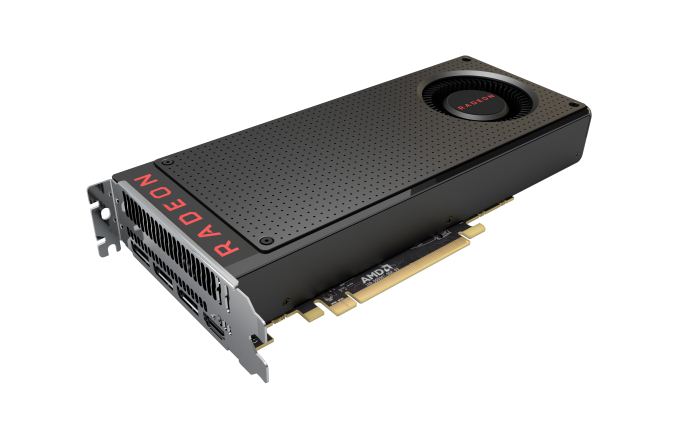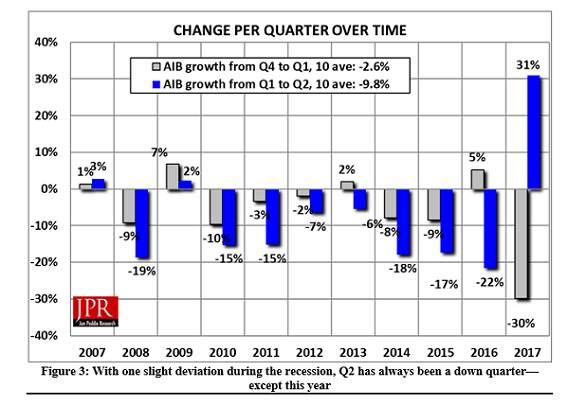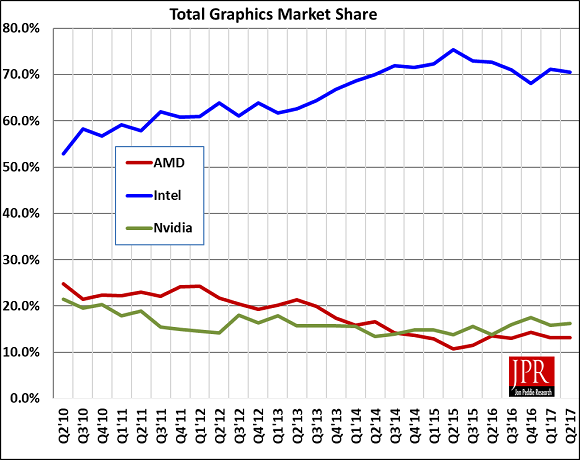Cryptomining Demand Drives Exceptionally High Graphics Card Shipments in Q2 2017
by Nate Oh on August 25, 2017 2:00 PM EST
This week, Jon Peddie Research (JPR) reported significantly higher discrete GPU shipments for Q2 2017, attributing the historically unprecedented increase to cryptocurrency mining, specifically to Ethereum mining. As opposed to the cryptocurrency mining demand of a few years ago, JPR notes that the ASIC-resistant nature of Ethereum mining has especially encouraged GPU mining. In terms of discrete desktop graphics market share, AMD gained a few percentage points from NVIDIA, bringing the current balance to AMD’s 29.4% versus NVIDIA’s 70.6%.
In context, the GPU and PC markets fluctuate in a relatively consistent seasonal pattern: shipments trend flat to down in Q1, notably down in Q2, notably up in Q3, and up to flat in Q4. According to JPR, Q2 2017 has seen an unprecedented 31% increase in discrete GPU shipments from Q1, the first time in over eight years that Q1-to-Q2 shipments have seen an increase at all. Discounting the minor increases during the recession, Q2 has always been the seasonally weak quarter for graphics card shipments.
Drawing a contrast to the limited Bitcoin and Litecoin mining impact on 2013 shipments, JPR identifies the memory-intensive Ethash, Ethereum’s hashing algorithm, as deterring ASIC development for Ethereum mining, and in turn any sudden GPU-displacing bust. That is, during the Bitcoin boom, low cost ASICs displaced GPUs. Consequently, JPR does not see a repeat of market cannibalization by used mining cards. While the diminishing return-on-investment (ROI) will eventually flatten out Ethermining-fueled GPU demand, this quarter saw a direct and significant Ethermining/cryptomining impact on discrete graphics demand.
On the back of that cryptomining demand, discrete GPUs have regained market share over integrated GPUs (iGPUs). Weak iGPU and desktop PC shipment numbers continue to reflect the overall declining PC market, while the high-end gaming PC sector continues to be the bright spot for the market. Overall, GPU shipments increased by 7.2% from last quarter.
Vendor-wise, JPR reports that AMD’s overall unit shipments increased 7.8% quarter-to-quarter, Intel’s shipments increased 6.3%, and NVIDIA’s shipments increased 10.4%. As mentioned earlier, AMD did gain market share in discrete desktop graphics, but still remains below last year’s market share level.
For AMD, their market share is back to Q2 2016 levels of around ~30%. The past year has seen launches of NVIDIA’s Pascal-based consumer cards, as well as of AMD’s Polaris-based RX 400 and 500 series cards; of the latter, the Polaris-based cards were explicitly a volume-play, and did not target the high-end market. To that end, the GTX 1070 and above did not have competition until this month, with AMD’s launch of RX Vega cards, and on the face of it, while Polaris has improved AMD's market share against NVIDIA, it has not made a dramatic difference. As the next few months roll on, the RX Vega cards, as well as Vega 11-based cards, will play a large role in AMD’s aspiring return to its historical 35% – 40% discrete desktop GPU market share.
For cryptomining demand, the remarkable impact on discrete graphics shipments does match up with general reports of mainstream graphics card shortages. When we looked at the discrete graphics market in Q2 and Q3 of 2016, the cryptocurrency mining demand then was nothing like this quarter. Now that the Ethereum mining mania has been quantified into numbers, it has revealed some of the context and reasoning behind cryptomining cards, cryptomining motherboards, and Radeon Pack bundles. And what the numbers reveal is that Ethereum GPU mining has been ridiculous in every sense of the word.
While Ethereum itself will die down eventually, it is anybody’s guess if GPU cryptomining booms will be firmly part of graphics card economics.
Source: Jon Peddie Research














46 Comments
View All Comments
Yojimbo - Friday, August 25, 2017 - link
You are directly contradicting JPR with that claim.And how else do you explain the unseasonably strong GPU demand? 31% Q/Q gain in shipments in Q2. Historically there is about a 10% decline in Q2 compared with Q1.
Furthermore, NVIDIA displayed about $200 M in cryptocurrency sales in their Q2 earnings via sales to large miners. They reported this income in their "OEM & IP" segment and you can estimate the revenue. That doesn't include small miners buying retail cards for mining. Both AMD and NVIDIA acknowledged strong cryptocurrency mining impact in Q2 in their conference calls.
CaedenV - Friday, August 25, 2017 - link
I am very curious to see how commercial block-chain usage will change all of this. Bitcoins and Etherium are interesting, but companies like large banks and MS are looking at blockchain tech for lots of other uses. I wonder if companies will need their own in-house servers to run these blockchains, or if there will be block rewards to the general public for doing the mining for them.WinterCharm - Friday, August 25, 2017 - link
Blockchains depend on everyone having a copy of the ledger. If it was internal only it would not be a very trustworthy blockchain.This is why Ether is so important. It lets others leverage the massive public blockchain, making it insanely difficult to alter what was already written in the blockchain.
Yojimbo - Friday, August 25, 2017 - link
I think companies intend to do block chain services. They set up in places with cheap electricity and can potentially sell various security products and services along with the block chain services.nfriedly - Friday, August 25, 2017 - link
> JPR does not see a repeat of market cannibalization by used mining cardEthereum is supposed to eventually switch to a proof-of-stake system, which wouldn't need GPUs for mining. So I think that crash will happen eventually, perhaps even this year (although that is becoming increasingly unlikely.)
Yojimbo - Friday, August 25, 2017 - link
From what I've heard, that keeps getting pushed back. Some people seem to believe it will never actually happen. Any idea when they currently plan to actually make the switch?vladx - Saturday, August 26, 2017 - link
It's been delayed to 2nd half of 2018, a difficulty bomb delay is planned to that effect until then.BrokenCrayons - Friday, August 25, 2017 - link
The market share graph merely proves the point that, in order to sell a large number of games, developers should be working toward ensuring said games run very well on Intel's iGPUs. Targeting dGPUs means eliminating 2/3rds of potential sales or more depending on what generation of dGPU we're talking about sticking into the system requirements.FreckledTrout - Friday, August 25, 2017 - link
Not really since a large portion of the iGPU sales are for machines that would never play a game. You would need to use something game centric like Steam stats to draw that conclusion. Hell even some server chips have iGPU's now a days.Yojimbo - Friday, August 25, 2017 - link
Hmm, no I don't think it shows that at all. One must consider who the potential customers for the games are. What percentage of people with only an iGPU are looking to play newly released games? How many of those systems sold with only an iGPU are sitting in a cubicle somewhere, anyway? You can't count all iGPUs as "potential sales".Additionally, almost all computers come with an iGPU. According to JPR the attach rate for GPUs this past quarter was 146%. So a good number of those iGPUs you are counting are actually paired with a dGPU.
If we look at Steam's hardware survey and look at the percentage of all users with DX 12 graphics who are using Intel iGPUs it is 6.62%. No AMD iGPU even shows up on the list because they've had such a small market share. The number of regular Steam users with DX 12 graphics capability, an AMD CPU, and no dGPU is minuscule. Btw, DX12 graphics accounted for 78% of all respondents in July. If we include all GPUs capable of DX11 or above graphics, then iGPUs account for 12% of those. To restate it for clarity, 88% of Steam survey respondents who had a DX11-capable GPU were using a dGPU.
So, the percentage of people looking to buy a newly released game (potential sales) who only have an iGPU is far smaller than you are claiming. It's probably less than the 12% of Steam survey respondents with a DX11 capable GPU that were using an iGPU.